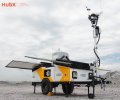
Maps Mania discovered the What did the World Look Like web map that shows Earth in its different stages of continental drift and the evolution of life on Earth. The above image is what Earth would have looked like 470 million years ago when the first vertebrates appeared.
By comparison, Danish newspaper Dagsbladet showed the speed and severity of the of the Islamic State’s dominance across Iraq and Syria, as shown by this map of 5,223 air strikes made against Islamic State since August2015. Share (yet again) by Maps Mania.
This Greenbiz article offers some sobering facts about species loss and what new geo-technologies can offer for wildlife conservation – a whole lot.
sUAS news shared a 3D model created using UAV that shows the before and after in Kathmandu following the severe 2015 Earthquake, thereby digitally preserving invaluable cultural heritage.
One problem with printed maps is that too much information is crammed into the one sheet of paper. Digital is not the only solution: Geoawsomeness shared the ‘bath °C thermo color map,’ which highlights different tourist detail depending on the weather, such as parks when it’s warm, or indoor hangouts when cold.
Geoawesomeness also discussed just what the acquisition of HERE maps will mean for us all (i.e. for Nokia, carmakers, TomTom, Google and the geo industry). Overall, “a positive impact for everyone.”
Citylab shared the team from Yale University’s interactive map that shows how global air pollution varies right down to the local level.
Cute Alert: These drone images on The Stranger show how closely killer whales keep their calves by their side and nuzzle one another. Don’t seem like seem like such killers after all.













